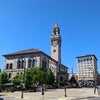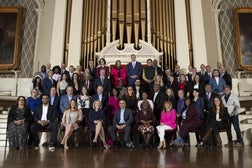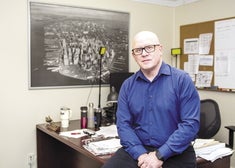
The nation’s largest bank is opening its first branch in Worcester, as local banks adjust to a changing market
 Photo | Timothy Doyle
The Chase branch on Gold Star Boulevard is the bank's first Worcester location.
Photo | Timothy Doyle
The Chase branch on Gold Star Boulevard is the bank's first Worcester location.
A new bank has come to town. And it’s a big one.
Chase, a division of New York City-based JPMorgan Chase & Co., has a branch now at Gold Star Boulevard in Worcester. Chase is the largest bank in the U.S., by assets, according to the Federal Financial Institutions Examinations Council. At 3,000 square feet, the full-service Worcester branch is now open, offering services such as home lending and business banking.

But how will Chase’s arrival impact local financial institutions, especially with several – such as Main Street Bank, Avidia Bank, Webster Five, and Cornerstone Bank – having decreased or held off on opening new branches, while Chase plans to double its Massachusetts footprint?
Will a big bank like Chase put Central Massachusetts-headquartered banks at a disadvantage? Industry leaders here don’t think so.
Al Ahmed, executive vice president, retail banking for 10-branch Cornerstone Bank of Worcester, sees it as good news for consumers.

“I don’t see it as big versus small, but having more banking options for customers in our community,” Ahmed said. “Whether digital or in-person offerings, our communities require a mix of all.”
Roxann Cooke, Chase regional director, and Massachusetts Bankers Association President & CEO Kathleen Murphy agree. Both say competition strengthens communities.
“This is not a matter of outpacing the other banks,” Cooke said.

“A bank branch in a community where that branch will be successful is a very positive reflection of the local economy as a whole,” said Murphy. “It’s good for the consumers and for business. What’s good about business here is that it travels all over the world.”
Right-sizing
Chase will strive to have customers avoid the experience of a big-bank vibe though, full of heavy automation and scarcity of real people. The branch will have eight to 12 employees, all local hires, said Cooke.
“Our branch manager, who has been helping with our branch in Boston, lives in Worcester,” said Cooke. “When this opportunity came up, he raised his hand. Not that he minded the commute, but he wanted to give back to the community where he lives with his family.”
Branch offerings are driven by what consumers want most, and human contact is still in demand, and not just for older customers.
According to American Bankers Association data collected from Oct. 1-3, post-pandemic, 4% of Gen Z customers, 5% of Millennial banking consumers, 10% of Gen X customers, and 17% of Baby Boomer banking clients use branches.
Murphy said there are so many banking options now, but some transactions (she uses the closing of her late father’s estate as an example) still need to be done face-to-face with a banking employee, at a branch.
“You just can’t do that with an app,” she said.

Big bank, big plans
Before now, the Central Massachusetts locations for Chase had been Framingham and Acton. Next year, Chase plans to open a branch in Springfield and has its sights set on Cape Cod as well, doubling its 36 Massachusetts branches by 2025.
Chase sees itself as a member of the community, just like the more-entrenched smaller banks, but these inroads aren’t assumed, said Cooke.
“I tell my team all the time: ‘Just because you can build it doesn’t mean they are going to come,’” she said. “You have to build that trust.”
For Chase, it has meant making connections in the community’s chamber of commerce, organizations like Worcester nonprofit Abby’s House, and being intentional about local commitment.
Central Massachusetts has seen some bank branch consolidation, though. From 2018 to 2021, the 15 largest banks in the region, ranked by local deposits, had a net loss of 11 branches, according to a Worcester Business Journal examination of Federal Deposit Insurance Corp. data.
Murphy is quick to warn of broad generalizations, noting each bank branch decision is made on highly unique and individual factors.
Closures can be related to overlapping, Murphy said, like when two banks are near one another and merge, and it’s determined how the institution will serve the market as a combined entity.
Ahmed, of Cornerstone, which recently closed its Warren location, said reasons for closures can vary greatly.
It may be related to volume of traffic, better alignment of service areas, or more efficient resource management of personnel or marketing, he said.
Every branch – its location and scenario – are highly individual.
“Some open, some close, it depends on their strategy,” Murphy said.
To illustrate this point, Murphy said last year Massachusetts had 136 banks and 2,048 branches, according to the Federal Deposit Insurance Corp. Due to consolidation, there are now 132 banks and 1,961 branches.
“Branches do remain critically important to consumers,” said Cooke.













0 Comments